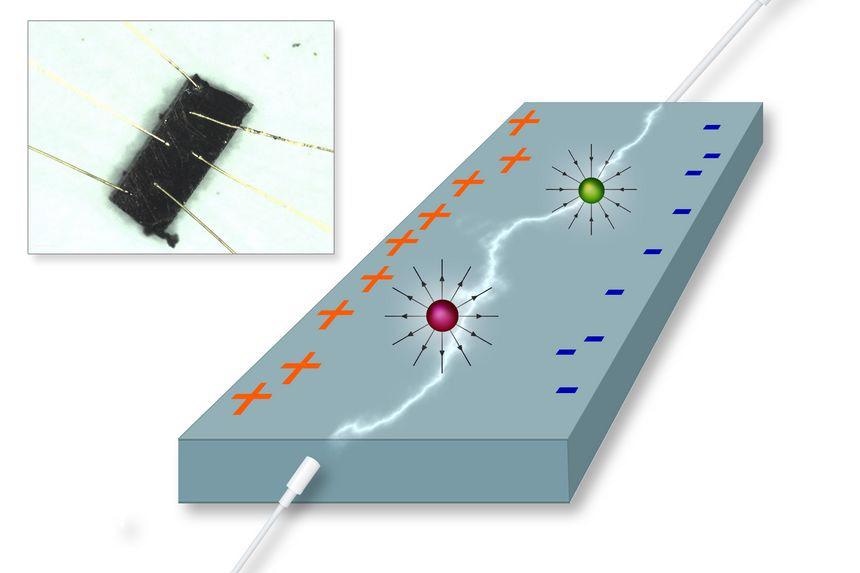Feb 23 2021
A magnetic field can deflect an electric current. In the case of conducting materials, this results in what is called the Hall effect, which is usually used to quantify magnetic fields.
 The material behaves as if magnetic monopoles were present. Image Credit: TU Wien.
The material behaves as if magnetic monopoles were present. Image Credit: TU Wien.
Scientists at TU Wien, working with researchers from the Paul Scherrer Institute (Switzerland), McMaster University (Canada) and Rice University (United States), have now achieved a fascinating discovery: an exotic metal composed of cerium, palladium and bismuth was investigated and the material was found to produce a giant Hall effect, in the complete absence of any magnetic field.
The reason for this unpredicted outcome is due to the strange properties of the electrons: They act as if magnetic monopoles existed in the material. These findings have been reported in the scientific magazine PNAS.
A Voltage Perpendicular to the Current
Electric current flowing through a metal strip makes electrons move from one side to the other. A magnet placed close to this strip exerts a force on the electrons—what is called the Lorentz force.
The electrons’ path through the metal strip changes from being straight to a little bent. Thus, there now exist more electrons on one side of the strip compared to the other, and this develops a voltage—in a direction perpendicular to the one along which current flows. This is denoted as the classic Hall effect and has been known for several years.
Measuring the strength of the Hall effect is one of the ways we characterise materials in our laboratory. You can learn a lot about the behaviour of electrons in the solid state from such an experiment.
Silke Bühler-Paschen, Professor, Institute of Solid State Physics, TU Wien
While investigating the material Ce3Bi4Pd3, Sami Dzsaber, working on his dissertation in Bühler-Paschen’s research group, took his task with utmost seriousness and conducted a measurement in the absence of a magnetic field. “Actually, this is an unusual idea—but in this case it was the decisive step,” added Silke Bühler-Paschen.
The measurement showed that the material displays a Hall effect even in the absence of an external magnetic field—and not merely the usual Hall effect, but an enormous one. In the case of normal materials, such a huge Hall effect can be produced only with huge electromagnetic coils.
“So we had to answer another question,” noted Silke Bühler Paschen. “If a Hall effect occurs without an external magnetic field, are we perhaps dealing with extremely strong local magnetic fields that occur on a microscopic scale inside the material, but can no longer be felt outside?”
Therefore, tests were performed at the Paul Scherrer Institute in Switzerland: The researchers used muons—elementary particles specifically well suited for examining magnetic phenomena—to investigate the material more closely. However, it was found that no magnetic field could be observed even on a microscopic scale.
“If there is no magnetic field, then there is also no Lorentz force that can act on the electrons in the material—but nevertheless a Hall effect was measured. That is really remarkable,” added Silke Bühler-Paschen.
Symmetry is What Counts
The interpretation of this strange phenomenon can be done using the complex interaction of the electrons.
The atoms of this material are arranged according to very specific symmetries, and these symmetries determine the so-called dispersion relation—that is the relationship between the energy of the electrons and their momentum. The dispersion relation tells us how fast an electron can move when it has a certain energy.
Silke Bühler-Paschen, Professor, Institute of Solid State Physics, TU Wien
“It’s also important to note that you can’t look at the electrons individually here—there are strong quantum mechanical interactions between them,” she continued.
Such a complex interaction leads to phenomena that mathematically appear as if magnetic monopoles exist in the material—that is, solitary north and south poles, which do not occur so in nature. “But it actually has the effect of a very strong magnetic field on the movement of the electrons,” stated Bühler-Paschen.
Although scientists had already predicted the effect theoretically for simpler materials, it has not been proved so far. The advancement was achieved through the examination of a new class of materials: “Our material with the chemical composition Ce3Bi4Pd3 is characterised by a particularly strong interaction between the electrons,” she explained.
“This is known as the Kondo effect. It causes these fictitious magnetic monopoles to have exactly the right energy to influence the conduction electrons in the material extremely strongly. This is the reason why the effect is more than a thousand times larger than theoretically predicted,” added Bühler-Paschen
The new massive spontaneous Hall effect is somewhat promising for next-generation quantum technologies. In this field, for instance, non-reciprocal elements generating direction-dependent scattering completely in the absence of an external magnetic field are crucial; they could be achieved with this effect.
The extremely non-linear behaviour of the material is also of great interest. The fact that complex many-particle phenomena in solids give rise to unexpected application possibilities makes this field of research particularly exciting.
Silke Bühler-Paschen, Professor, Institute of Solid State Physics, TU Wien
Journal Reference:
Dzsaber, S., et al. (2021) Giant spontaneous Hall effect in a nonmagnetic Weyl–Kondo semimetal. Proceedings of the National Academy of Sciences. doi.org/10.1073/pnas.2013386118.